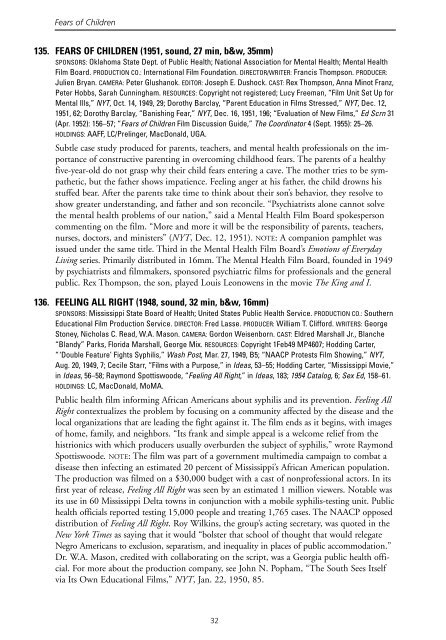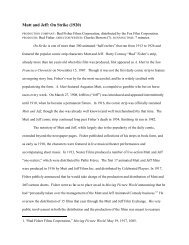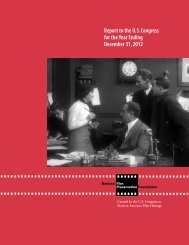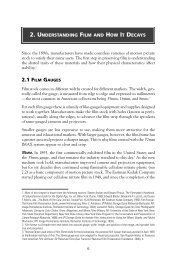Field Guide to Sponsored Films - National Film Preservation ...
Field Guide to Sponsored Films - National Film Preservation ...
Field Guide to Sponsored Films - National Film Preservation ...
Create successful ePaper yourself
Turn your PDF publications into a flip-book with our unique Google optimized e-Paper software.
Fears of Children<br />
135. FEARS OF CHILDREN (1951, sound, 27 min, b&w, 35mm)<br />
SPONSORS: Oklahoma State Dept. of Public Health; <strong>National</strong> Association for Mental Health; Mental Health<br />
<strong>Film</strong> Board. PRODUCTION CO.: International <strong>Film</strong> Foundation. DIRECTOR/WRITER: Francis Thompson. PRODUCER:<br />
Julien Bryan. CAMERA: Peter Glushanok. EDITOR: Joseph E. Dushock. CAST: Rex Thompson, Anna Minot Franz,<br />
Peter Hobbs, Sarah Cunningham. RESOURCES: Copyright not registered; Lucy Freeman, “<strong>Film</strong> Unit Set Up for<br />
Mental Ills,” NYT, Oct. 14, 1949, 29; Dorothy Barclay, “Parent Education in <strong><strong>Film</strong>s</strong> Stressed,” NYT, Dec. 12,<br />
1951, 62; Dorothy Barclay, “Banishing Fear,” NYT, Dec. 16, 1951, 196; “Evaluation of New <strong><strong>Film</strong>s</strong>,” Ed Scrn 31<br />
(Apr. 1952): 156–57; “Fears of Children <strong>Film</strong> Discussion <strong>Guide</strong>,” The Coordina<strong>to</strong>r 4 (Sept. 1955): 25–26.<br />
HOLDINGS: AAFF, LC/Prelinger, MacDonald, UGA.<br />
Subtle case study produced for parents, teachers, and mental health professionals on the importance<br />
of constructive parenting in overcoming childhood fears. The parents of a healthy<br />
five-year-old do not grasp why their child fears entering a cave. The mother tries <strong>to</strong> be sympathetic,<br />
but the father shows impatience. Feeling anger at his father, the child drowns his<br />
stuffed bear. After the parents take time <strong>to</strong> think about their son’s behavior, they resolve <strong>to</strong><br />
show greater understanding, and father and son reconcile. “Psychiatrists alone cannot solve<br />
the mental health problems of our nation,” said a Mental Health <strong>Film</strong> Board spokesperson<br />
commenting on the film. “More and more it will be the responsibility of parents, teachers,<br />
nurses, doc<strong>to</strong>rs, and ministers” (NYT, Dec. 12, 1951). NOTE: A companion pamphlet was<br />
issued under the same title. Third in the Mental Health <strong>Film</strong> Board’s Emotions of Everyday<br />
Living series. Primarily distributed in 16mm. The Mental Health <strong>Film</strong> Board, founded in 1949<br />
by psychiatrists and filmmakers, sponsored psychiatric films for professionals and the general<br />
public. Rex Thompson, the son, played Louis Leonowens in the movie The King and I.<br />
136. FEELING ALL RIGHT (1948, sound, 32 min, b&w, 16mm)<br />
SPONSORS: Mississippi State Board of Health; United States Public Health Service. PRODUCTION CO.: Southern<br />
Educational <strong>Film</strong> Production Service. DIRECTOR: Fred Lasse. PRODUCER: William T. Clifford. WRITERS: George<br />
S<strong>to</strong>ney, Nicholas C. Read, W.A. Mason. CAMERA: Gordon Weisenborn. CAST: Eldred Marshall Jr., Blanche<br />
“Blandy” Parks, Florida Marshall, George Mix. RESOURCES: Copyright 1Feb49 MP4607; Hodding Carter,<br />
“‘Double Feature’ Fights Syphilis,” Wash Post, Mar. 27, 1949, B5; “NAACP Protests <strong>Film</strong> Showing,” NYT,<br />
Aug. 20, 1949, 7; Cecile Starr, “<strong><strong>Film</strong>s</strong> with a Purpose,” in Ideas, 53–55; Hodding Carter, “Mississippi Movie,”<br />
in Ideas, 56–58; Raymond Spottiswoode, “Feeling All Right,” in Ideas, 183; 1954 Catalog, 6; Sex Ed, 158–61.<br />
HOLDINGS: LC, MacDonald, MoMA.<br />
Public health film informing African Americans about syphilis and its prevention. Feeling All<br />
Right contextualizes the problem by focusing on a community affected by the disease and the<br />
local organizations that are leading the fight against it. The film ends as it begins, with images<br />
of home, family, and neighbors. “Its frank and simple appeal is a welcome relief from the<br />
histrionics with which producers usually overburden the subject of syphilis,” wrote Raymond<br />
Spottiswoode. NOTE: The film was part of a government multimedia campaign <strong>to</strong> combat a<br />
disease then infecting an estimated 20 percent of Mississippi’s African American population.<br />
The production was filmed on a $30,000 budget with a cast of nonprofessional ac<strong>to</strong>rs. In its<br />
first year of release, Feeling All Right was seen by an estimated 1 million viewers. Notable was<br />
its use in 60 Mississippi Delta <strong>to</strong>wns in conjunction with a mobile syphilis-testing unit. Public<br />
health officials reported testing 15,000 people and treating 1,765 cases. The NAACP opposed<br />
distribution of Feeling All Right. Roy Wilkins, the group’s acting secretary, was quoted in the<br />
New York Times as saying that it would “bolster that school of thought that would relegate<br />
Negro Americans <strong>to</strong> exclusion, separatism, and inequality in places of public accommodation.”<br />
Dr. W.A. Mason, credited with collaborating on the script, was a Georgia public health official.<br />
For more about the production company, see John N. Popham, “The South Sees Itself<br />
via Its Own Educational <strong><strong>Film</strong>s</strong>,” NYT, Jan. 22, 1950, 85.<br />
32















